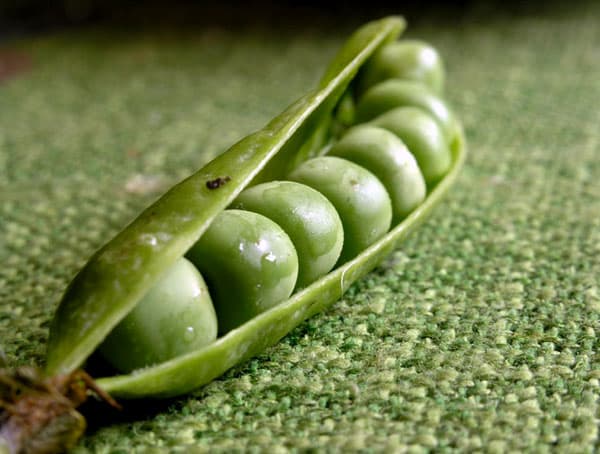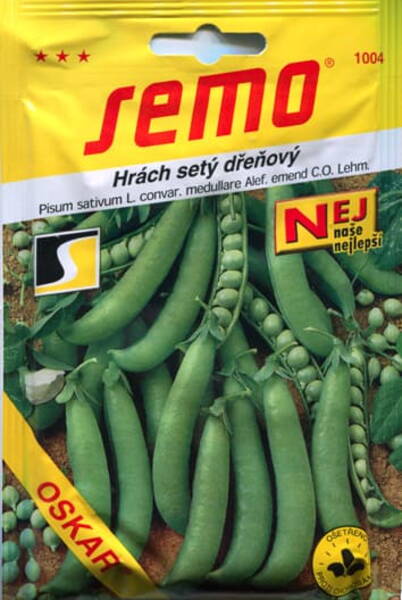Ex Tax: 1.45€
Pods without parchment layer!
Very popular variety because of very early production of long pods.
OSKAR offers big seeds and a high yield. Excellent for mechanized harvest and also hand harvest of whole pods.
Resistant to Fusarium oxysporum race 1.
Plant height: 70-80 cm.
Pod length 9 cm.
The pod contains: 8-10 peas.
Days to ripeness: 65-70.
1,0 g = 3-5 seeds.

Sugar Pea. Bot.: Pisum sativum L. convar. medullare Alef. emend C.O. Lehm.
Preparation of pea seeds for sowing. For sowing, it is necessary to select large healthy seeds and test them for germination.
In order to sort out seeds damaged by a pea weevil and select more full-weight ones, they are immersed in a 3% solution of table salt (30 g of salt per 1 litre of water).
The floating seeds are removed and the seeds that have settled to the bottom are washed in clean water, and then dried.
Seedling method of sowing peas. Seedlings are grown in boxes on windows and in greenhouses. To obtain it, 2-3 thousand seeds are sown per 1 sq. m.
This amount of seedlings is enough for a hundred.
They begin to grow it a month before landing in the ground. Subsequently planted in the ground on a flat surface.
Ridges are cut with a width of 1 m, transverse grooves are made at a distance of 30 cm from each other and plants are planted in rows at a distance of 10 cm from one another.
Before planting, the grooves are watered. After planting seedlings, the fruits ripen in about a month.
Site preparation and sowing seeds in the ground. Peas successfully grow on soils with a wide range of soil reactions (pH 5.5-7).
But it is better to take neutral soils for this culture. Acidic soils are unsuitable for peas.
Best of all, peas succeed on medium loamy, rather moisture-intensive, humus-rich, non-weedy soils. Good yields are also obtained on other, less rich soils.
But it is necessary to avoid sowing peas on saline and light sandy soils. Heavy, swollen and acidic soils are completely unsuitable for peas.
Attention! On poor soils without fertilizers, peas give low yields, beans and seeds are small, low in sugar, coarse and with low starch content.
Plants on such soils develop poorly in the initial period and are strongly oppressed by weeds.
Thus, with the exception of very poor sandy and heavy acidic clay soils, all the rest are suitable for growing peas.
Smooth-seed varieties are very cold-resistant. They perfectly withstand short-term frosts down to -4-5 ° C.
Peas prefer sunny places, and warm weather during flowering is very beneficial for yields.
The best predecessors for peas are root crops, cucumbers, tomatoes, cabbage, and potatoes.
Sowing in one place should be carried out no earlier than after 4 years. Peas should not be sown next to related legumes and grasses (clover, alfalfa, beans, etc.).
In this case, the incidence of plants and the number of pests sharply increase. After harvesting peas, radishes can then be grown in this area.
Peas grow well in the aisles of the garden. Here, after harvesting the fruits, the entire aerial part of the plant must be embedded in the soil. The neighbourhood of apple trees with peas mutually adds to the harvest.
The soil must be dug up twice: in the fall after harvesting the predecessor and in the spring before sowing.
The soil must be dug deep to provide good air access to the roots (only in this case, nodule bacteria that fix nitrogen work actively).
Good yields of vegetable peas are obtained by filling the soil with humus or compost (half a bucket per 1 m2) for autumn digging of the soil after harvesting
the previous crop and the application of mineral fertilizers (30-40 g of superphosphate and 20-30 g of potassium chloride per 1 sq. M).
In the spring, before sowing, nitrogen fertilizers are applied (15-20 g of urea or 20-30 g of ammonium nitrate).
If peas are sown on the site for the first time, when planting in the soil, the bacterial preparation Nitragin is introduced along with the seeds.
In favourable climatic conditions, peas are sown in the first half of March. Smooth-seed peas are sown first.
Sugar varieties are sown in the second half of March. Varieties with shrivelled seeds (very sensitive to cold weather) can be sown no earlier than mid-April,
as they germinate when the soil temperature rises above +8°C. In principle, they can be sown at the end of April, but the yield, in this case, will be much lower.
Before sowing, do not forget to disinfect the seeds, which will significantly increase the resistance of plants to bacterial and fungal diseases.
From 20 to 25 g is sown per 1 m2 (depending on the size of the seeds), in rows, with a row spacing of 25-30 cm. The distance between seeds in a row is 3-5 cm. The depth of placement is 4-5 cm.
To facilitate harvesting, you can sow peas in "belts" - two rows with a row spacing of 25 cm, and then a track 50 cm wide.
Pea crops need to be protected from birds by stretching a net or tulle curtain over the bed. Or crops before germination are covered with paper or a translucent film.
It is even better to sow peas at several times, using varieties with different ripening periods. Sowing begins at the end of April - beginning of May and is completed, as a rule, at the end of May.
The peas are sown in a two-line band pattern, which facilitates multiple hand-picking of the beans.
The distance between the ribbons is 50 cm, between the lines - is 20 cm for peeling varieties (for green peas) and 40 cm for sugar varieties per shoulder and between plants in a row - is 4-6 cm.
Seeding depth on heavy soils is 3-4 cm and on light soils -5-6 cm. Seeding rate: 15-20 g per 1 m2.
After sowing, the soil is rolled on top (compacted).
Attention! The vegetable pea is a cold-resistant plant. Its seeds begin to germinate at +4+6°C. Seedlings withstand short-term frosts down to -4°C.
Flowering begins 30-55 days after sowing.












